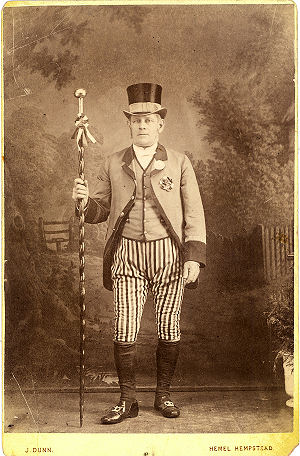I regularly prowl ebay looking for low priced items linked to Hertfordshire which I think will make a good story on this blog. A few days ago this cabinet card came on the market. I knew I would have something to say about it because the photographer was
Julianna Dunn, one of the few Victorian female photographers in Hertfordshire, whose studio had been next door to the house where my mother lived as a child, and who trained with another of my relatives in Aylesbury,
Samuel Glendenning Payne.
The truth was the subject intrigued me. Why was the man dressed up in that way, and why was he carrying a staff. A fancy dress ball came to mind - but if so who or what was he supposed to be. There was a name on the back "Simon Wallis" written in a shaky hand so there was a chance of finding out who he was.
No-one else was interested so I won the item for a virgin bid of £5.00 - which is more than I would usually pay, and a couple of days ago it dropped through my letterbox.
My first reaction was one of disappointment in that there was no sign of anyone called "Simon Willis" in the Hertfordshire area. However the shaky handwriting might have been that of an elderly person trying to identify some old photographs many years later - so I had another look at the census and found Solomon Wallis - whose occupation was an "Under Bailiff".
Further investigation showed that he was an official of a Piedpowder Court and the first such courts, which originally operated in markets, started on the continent over a thousand years ago, and came to England with the Normans. Most such courts disappeared in the 17th century but one court almost made it to the 20th century thanks to Henry VIII. His charter to Hemel Hempstead provided it with a bailiff, elected by the jury of a Piepowder Court when most towns had a mayor elected by aldermen and burgers. And the bailiff (who was elected annually) would want a paid under bailiff to actually do the work.
Click here to find out more about Solomon Willis (who happened to be an exceptional cricketer) and his work.





Fascinating! I wonder what became of the staff.
ReplyDelete